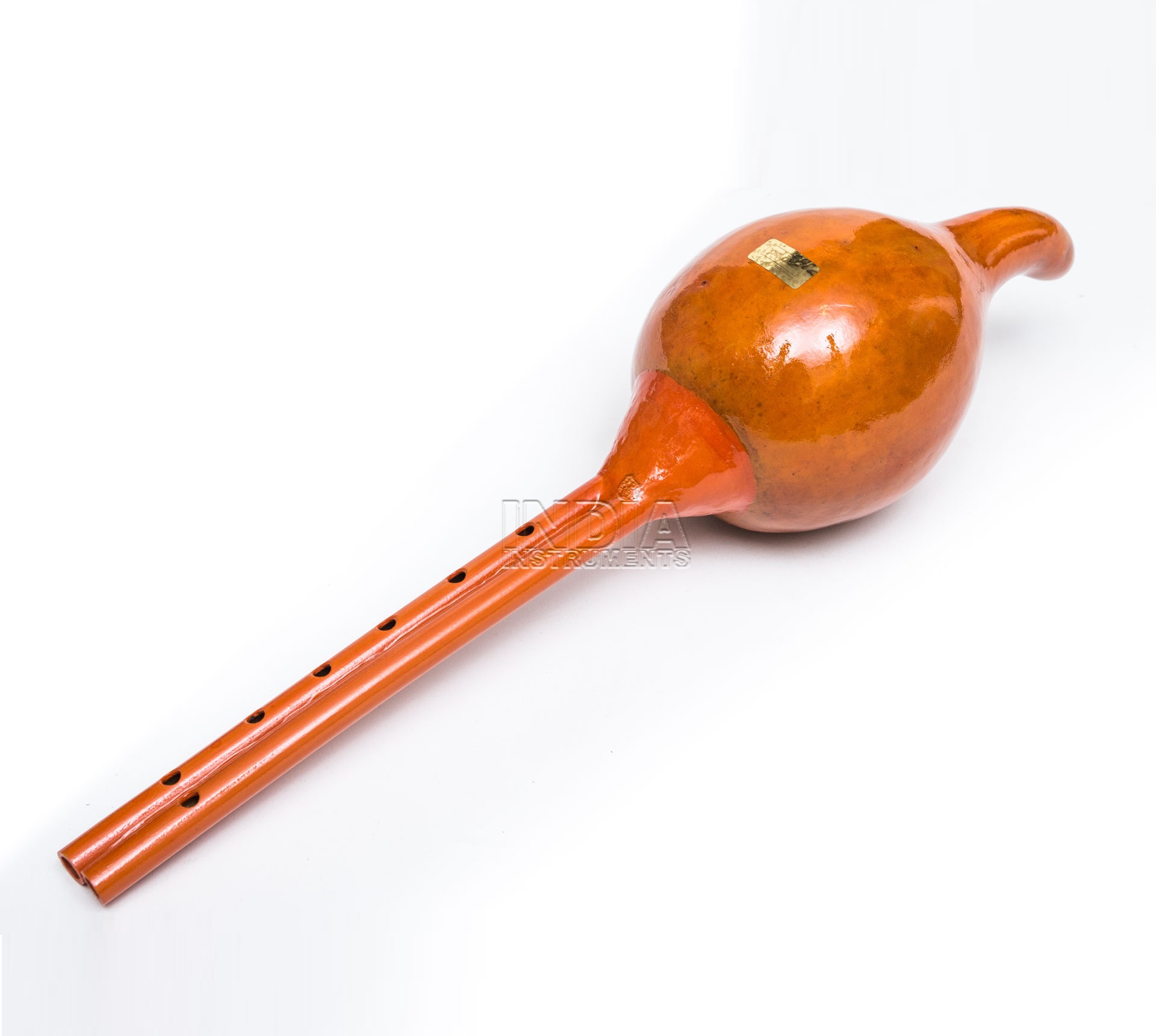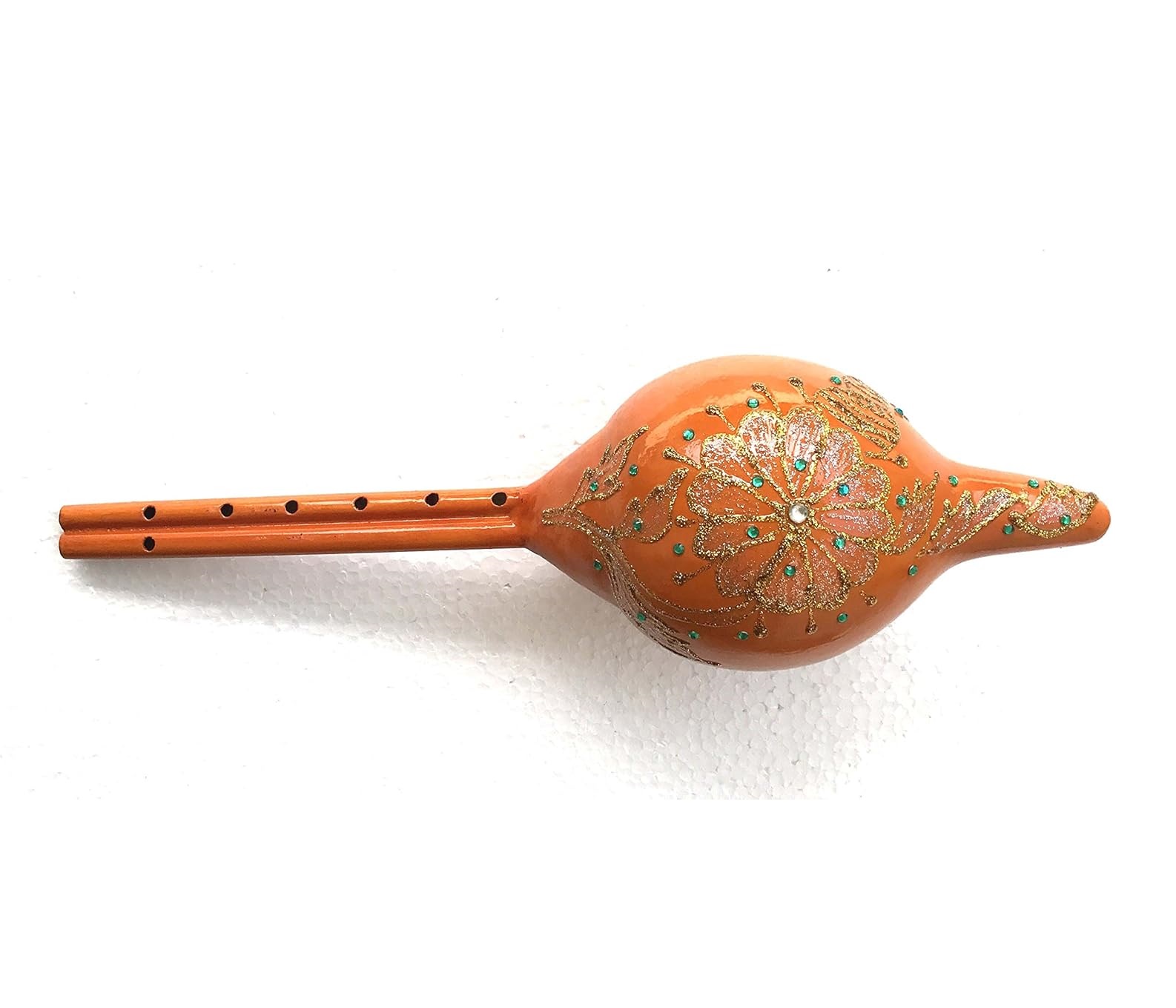Pungi
Woodwinds
Asia
Between 1001 and 1900 AD
Video
The Pungi is a traditional wind instrument primarily associated with Indian folk and classical music. It is a double-reeded aerophone with a distinctive gourd-shaped resonator. The instrument is particularly known for its continuous, hypnotic drone and its use in performances by snake charmers in India. The Pungi has a mouth-blown free reed system, and its design allows for a continuous flow of sound, making it unique among wind instruments.
The Pungi is classified as an aerophone, specifically a free-reed wind instrument. It consists of a main air reservoir (typically a gourd) and two reed pipes that produce the melody and drone effect. The instrument falls under the category of folk and traditional musical instruments and is widely used in ritualistic and street performances.
History
The Pungi, a traditional wind instrument from India, dates back to at least the 12th century and has deep roots in folk and religious music. Originally used by snake charmers, it was developed as a reed instrument with a gourd wind chamber and two attached pipes—one for melody and the other for drone accompaniment. The instrument is believed to have evolved from ancient reed-pipe instruments used in South Asian cultures, particularly in rituals and folk traditions. The Pungi is closely associated with the Bengal and Rajasthan regions, where it was played for spiritual and entertainment purposes. Over time, it influenced other Indian wind instruments like the Shehnai, which gained prominence in classical music. Despite modernization, the Pungi remains an iconic symbol of India’s street performances and cultural heritage.
Construction and Components
Traditionally, the Pungi is crafted from a dried bottle gourd or a hollow coconut shell, which acts as the main air chamber. Attached to this reservoir are two bamboo or cane pipes, each serving a distinct purpose: one produces a continuous drone, while the other plays the melody. The melody pipe typically features seven holes, enabling a range of notes within about one octave, whereas the drone pipe usually has only one hole. The reeds inside the pipes, traditionally made from natural materials like palm leaves, vibrate when air is blown into the instrument. While early versions were entirely made from organic materials such as bamboo and gourds, modern adaptations may include synthetic reeds or metallic components to enhance durability and tonal quality.
Types of Pungi
There are several variations of the Pungi found across different regions, each with unique adaptations:
Single-reed Pungi: Features only one pipe, typically producing a simple melody.
Double-reed Pungi: The most common form, where one pipe plays the melody while the other produces a constant drone.
Triple-pipe Pungi: A rare variation that includes an additional pipe to create a richer harmonic effect.
Regional Variants: Different states in India have their own localized versions, often with distinct tuning and playing styles.
Characteristics
The Pungi is characterized by its unique shape, continuous drone effect, and high-pitched, nasal tone. Its construction allows for circular breathing, enabling the player to sustain long phrases without interruption. The instrument is usually hand-carved and decorated with intricate patterns, reflecting the artisan craftsmanship involved in its creation. Due to its folk roots, the Pungi often exhibits variations in size and design, depending on the cultural region where it is made.
Sound Production
The sound of the Pungi is produced by blowing air into the gourd chamber, which then flows into the attached reed pipes. The reeds vibrate to generate sound, and the player’s finger placement on the holes of the melody pipe determines the pitch and notes. The drone pipe produces a continuous background hum, adding to the hypnotic quality of the instrument’s sound. The use of circular breathing allows for uninterrupted play, making the Pungi ideal for long, sustained performances.
Playing Methods
The Pungi is played by placing the mouth at the blowing hole of the gourd chamber and using breath control to produce a steady stream of air. The fingers of both hands are used to cover and uncover the finger holes on the melody pipe, creating different notes and modulations. Traditional players often use a technique called circular breathing, where they simultaneously inhale through the nose while exhaling through the mouth, ensuring a continuous sound. Mastery of the Pungi requires extensive practice, particularly in breath control and finger dexterity.
Roles in Music
The Pungi primarily serves as a solo instrument, used in street performances, folk rituals, and religious ceremonies. It is rarely included in classical ensembles but holds a special place in the performance traditions of snake charmers and folk musicians. The instrument is also used in traditional healing practices, where its sound is believed to have spiritual and therapeutic effects. In some cultural settings, the Pungi is played during festive occasions and storytelling performances.
Cultural Significance
The Pungi is deeply ingrained in Indian culture, symbolizing mysticism, tradition, and folklore. Its most famous association is with snake charmers, who use the instrument to mesmerize cobras as part of their performances. Beyond its connection to snake charming, the Pungi is considered a sacred instrument in some religious practices, where it is played to invoke spiritual blessings. In rural India, it is often played during harvest festivals and communal gatherings, serving as a means of entertainment and cultural expression.
Despite modernization, the Pungi continues to be an important symbol of India’s rich musical heritage. Efforts are being made to preserve and document traditional Pungi music, ensuring that its legacy endures for future generations. The instrument’s distinctive sound and cultural significance make it an enduring part of India’s musical and artistic landscape.
FAQ
What is a Pungi musical instrument?
The Pungi is a traditional Indian wind instrument, mainly used by snake charmers. It consists of a gourd with two reed pipes and produces a continuous, droning sound. It originated in folk music and religious ceremonies. The instrument is played using circular breathing to maintain a steady tone.
How does the Pungi produce sound?
The Pungi produces sound through its double-reed pipes, which vibrate when air is blown through the gourd. One pipe plays the melody while the other provides a drone effect. The musician uses circular breathing to sustain the sound. Its unique timbre makes it distinct in traditional Indian music.
What is the cultural significance of the Pungi?
The Pungi is strongly associated with Indian snake charmers and folk traditions. Historically, it was used in religious rituals and storytelling performances. The instrument symbolizes mystical and hypnotic elements in Indian culture. Though less common today, it remains an iconic folk instrument.
 Links
Links
References
Other Instrument
Categories



















